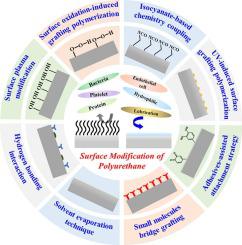当前位置:
X-MOL 学术
›
Adv. Colloid Interface Sci.
›
论文详情
Our official English website, www.x-mol.net, welcomes your feedback! (Note: you will need to create a separate account there.)
Surface functionalization of polyurethanes: A critical review
Advances in Colloid and Interface Science ( IF 15.6 ) Pub Date : 2024-02-04 , DOI: 10.1016/j.cis.2024.103100 Jinshuai Zhang , Siyao Lv , Xiaoduo Zhao , Shuanhong Ma , Feng Zhou
Advances in Colloid and Interface Science ( IF 15.6 ) Pub Date : 2024-02-04 , DOI: 10.1016/j.cis.2024.103100 Jinshuai Zhang , Siyao Lv , Xiaoduo Zhao , Shuanhong Ma , Feng Zhou

|
Synthetic polymers, particularly polyurethanes (PUs), have revolutionized bioengineering and biomedical devices due to their customizable mechanical properties and long-term stability. However, the inherent hydrophobic nature of PU surfaces arises common issues such as high friction, strong protein adsorption, and thrombosis, especially in the physiological environment of blood contact. To overcome these issues, researchers have explored various modification techniques to improve the surface biofunctionality of PUs. In this review, we have systematically summarized several typical surface modification methods including surface plasma modification, surface oxidation-induced grafting polymerization, isocyanate-based chemistry coupling, UV-induced surface grafting polymerization, adhesives-assisted attachment strategy, small molecules-bridge grafting, solvent evaporation technique, and hydrogen bonding interaction. Correspondingly, the advantages, limitations, and future prospects of these surface modification methods were discussed. This review provides an important guidance or tool for developing surface functionalized PUs in the fields of bioengineering and medical devices.
中文翻译:

聚氨酯的表面功能化:批判性评论
合成聚合物,特别是聚氨酯 (PU),由于其可定制的机械性能和长期稳定性而彻底改变了生物工程和生物医学设备。然而,PU表面固有的疏水性会带来摩擦力大、蛋白质吸附强、血栓形成等常见问题,特别是在血液接触的生理环境中。为了克服这些问题,研究人员探索了各种改性技术来改善聚氨酯的表面生物功能。在这篇综述中,我们系统地总结了几种典型的表面改性方法,包括表面等离子体改性、表面氧化诱导接枝聚合、异氰酸酯基化学偶联、紫外线诱导表面接枝聚合、粘合剂辅助附着策略、小分子桥接枝、溶剂蒸发技术和氢键相互作用。相应地,讨论了这些表面改性方法的优点、局限性和未来前景。该综述为生物工程和医疗器械领域开发表面功能化聚氨酯提供了重要的指导或工具。
更新日期:2024-02-04
中文翻译:

聚氨酯的表面功能化:批判性评论
合成聚合物,特别是聚氨酯 (PU),由于其可定制的机械性能和长期稳定性而彻底改变了生物工程和生物医学设备。然而,PU表面固有的疏水性会带来摩擦力大、蛋白质吸附强、血栓形成等常见问题,特别是在血液接触的生理环境中。为了克服这些问题,研究人员探索了各种改性技术来改善聚氨酯的表面生物功能。在这篇综述中,我们系统地总结了几种典型的表面改性方法,包括表面等离子体改性、表面氧化诱导接枝聚合、异氰酸酯基化学偶联、紫外线诱导表面接枝聚合、粘合剂辅助附着策略、小分子桥接枝、溶剂蒸发技术和氢键相互作用。相应地,讨论了这些表面改性方法的优点、局限性和未来前景。该综述为生物工程和医疗器械领域开发表面功能化聚氨酯提供了重要的指导或工具。



























 京公网安备 11010802027423号
京公网安备 11010802027423号